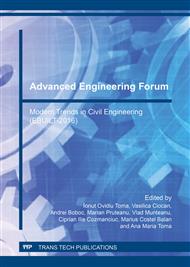[1]
E.F. Beznea, I. Chirică, Structuri compozite, Galaţi University Press Publisher, ISBN 978-606-8008-86-8, (2010).
Google Scholar
[2]
S. Adarsh, L. Manikanta, S.G. Sha, Application of polymer composites in civil engineering, I. J. of Innov. Research in Sci. and Eng. 2, Issue 04 (2016) 231-238.
Google Scholar
[3]
J.R. Correia, The new FRP materials for civil engineering structural applications, The 57th Meeting of the European Council of Civil Engineers (ECCE), Lisboa, (2013).
Google Scholar
[4]
I. Chirică, E.F. Beznea, Elasticitatea materialelor anizotrope, Ed. Fund. Univ., Galati, ISBN 973-627-176-5, (2004).
Google Scholar
[5]
H. Debski, T. Kubiak, A. Teter, Buckling and post-buckling behavior of thin-walled composite channel section column, Composite Structures 100 (2013) 195-204.
DOI: 10.1016/j.compstruct.2012.12.033
Google Scholar
[6]
H.T. Nguyen, S.E. Kim, Buckling of composite columns of lipped-channel and hat sections with web stiffener, Thin-Walled Structures 47 (2009) 1149-1160.
DOI: 10.1016/j.tws.2009.04.011
Google Scholar
[7]
O. Bedair, Design expression for web shear buckling of box sections by accounting for flange restraints, Journal of Constructional Steel Research 110 (2015) 163-169.
DOI: 10.1016/j.jcsr.2015.02.018
Google Scholar
[8]
K. Ramkumar, H. Kang, Finite element based investigation of buckling and vibration behavior of thin walled box beams, Applied and Computational Mechanics 7 (2013) 155-182.
Google Scholar
[9]
D. Lanc, G. Turkalj, I. Pesic, Global buckling analysis model for thin-walled composite laminated beam type structures, Composite Structures 111 (2014) 371-380.
DOI: 10.1016/j.compstruct.2014.01.020
Google Scholar
[10]
T.P. Vo, J. Lee, Interaction curves for vibration and buckling of thin-walled composite box beams under axial loads and end moments, Appl. Mathem. Modelling 34 (2010) 3142-3157.
DOI: 10.1016/j.apm.2010.02.003
Google Scholar
[11]
D. Shin, S. Choi, G.W. Jang and Y.Y. Kim, Finite element beam analysis of tapered thin-walled box beams, Thin-Walled Structures 102 (2016) 205-214.
DOI: 10.1016/j.tws.2016.01.028
Google Scholar
[12]
D. Henriques, R. Gonçalves, D. Camotim, GBT-based finite element to assess the buckling behavior of steel–concrete composite beams, Thin-Walled Structures 107 (2016) 207-220.
DOI: 10.1016/j.tws.2016.06.005
Google Scholar
[13]
C.C. Chen, J.W. Ko, G.L. Huang and Y.M. Chang, Local buckling and concrete confinement of concrete-filled box columns under axial load, J. of Construct. Steel Research 78 (2012) 8-21.
DOI: 10.1016/j.jcsr.2012.06.006
Google Scholar
[14]
E.F. Beznea, Studies and researches on the buckling behavior of the composite panels, Doctoral Thesis, Dunărea de Jos, University of Galati, (2008).
Google Scholar
[15]
F. Reguera, V.H. Cortínez, Optimal design of composite thin-walled beams using simulated annealing, Thin-Walled Structures 104 (2016) 71-81.
DOI: 10.1016/j.tws.2016.03.001
Google Scholar
[16]
U.K. Mallela, A. Upadhyay, Buckling load prediction of laminated composite stiffened panels subjected to in-plane shear using artificial neural networks, Thin-Walled Structures 102 (2016) 158-164.
DOI: 10.1016/j.tws.2016.01.025
Google Scholar
[17]
I. Chirică, R. Chirică, Structuri compozite cu pereţi subţiri, Editura Didactică şi Pedagogică. Bucureşti, ISBN 973-30-1270-X , (2005).
Google Scholar
[18]
I. Chirică, E.F. Beznea, R. Chirică, Numerical tests on the buckling of the plates made of composite materials, Proceedings: Modelling and optimization in the machines building field, Romanian Technical Sciences Academy 3, ISBN 1224-7480 (2006).
Google Scholar
[19]
E.F. Beznea, I. Chirică, Buckling of Composite Plates, chapter in Advances in composite materials - ecodesign and analysis, edited by Brahim Attaf, Ed. INTECH, 2011, pp.383-408.
DOI: 10.5772/13741
Google Scholar
[20]
D.B. Karunakar, G.L. Datta, Prevention of defects in casting using back propagation neural networks, Int. J. Adv. Manuf. Technol. (2007) DOI: 10. 1007/s00170-007-1289-0.
DOI: 10.1007/s00170-007-1289-0
Google Scholar
[21]
S. Bouhouche, M. Lahreche, J. Bast, Control of heat transfer in continuous casting process using neural networks, Acta Automatica Sinica 34 no. 6 (2008) 701-706.
DOI: 10.1016/s1874-1029(08)60034-8
Google Scholar


